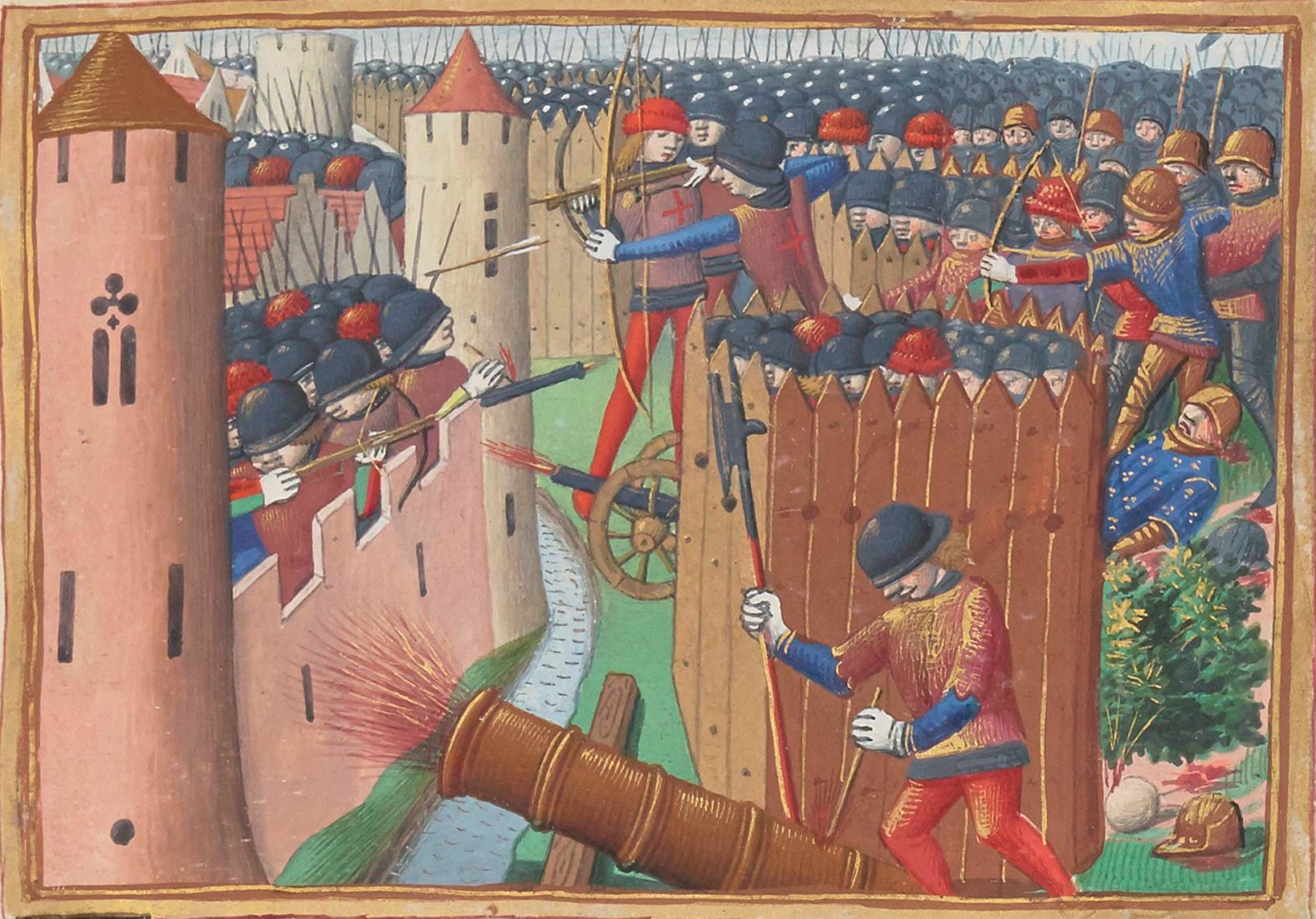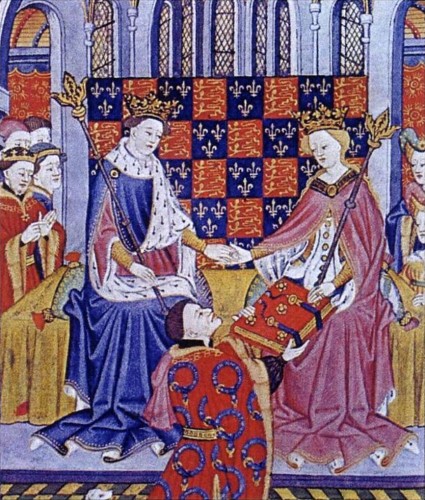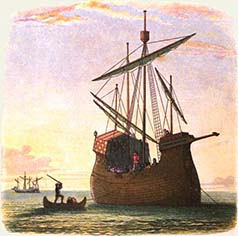William de la Pole, Duke of Suffolk, was a favourite in Henry VI's court whose self-invested policies would lead to public hatred and his death.
COMMANDER
He was born on 16 October 1396 at Cotton, Suffolk, son to Michael de la Pole, 2nd Earl of Suffolk, and Katherine de Stafford. Suffolk had served loyally in France for 17 years where he was seriously wounded in the Siege of Harfleur in 1415, commanded English forces at the Siege of Orléans in 1429 and surrendered shortly afterwards at Jargeau. Suffolk remained a prisoner of war until he was ransomed in 1431.
 |
| Suffolk unsuccessfully commanded the English in the Siege of Orleans |
Suffolk was rewarded for his service when he returned to England by being appointed Constable of Wallingford in 1434. He had been awarded command of Orléans after the death on 3 November 1428 of his friend, Thomas Montacute, 4th Earl of Salisbury. After returning from France, Suffolk married Salisbury's widow, Alice Chaucer, grand-daughter to poet, Geoffrey Chaucer. Suffolk was tired of war with the French and aligned himself with Cardinal Henry Beaufort who shared the same anti-war sentiment.
Beaufort clashed with Henry VI's uncle Humphrey, Duke of Gloucester, during the king's minority. Gloucester wanted to continue war with France following the disastrous Treaty of Arras in 1435 when England were betrayed by their traditional ally, Burgundy. Worse was to come for the young king when his mother, Catherine of Valois, died on 3 January 1437 and the king's half brothers, Edmund and Jasper Tudor, were placed in the care of Suffolk's sister, abbess of Barking Abbey, Katherine de la Pole.
Henry VI came of age in 1437 but still deferred to his Council and rewarded Beaufort's faction with lands and titles. Richard, Duke of York's lieutenancy of France was undermined by John Beaufort, 1st Duke of Somerset, naming himself Lieutenant of Aquitaine and Captain-General of Guienne. The king gave Somerset much needed troops and resources away from York and this would be the first of many disregards the king had for York, setting in motion the conflicts that lay ahead.
MATCH MAKER
Somerset's daughter, Margaret Beaufort, was born on 31 May 1443 and Somerset negotiated with the king that Margaret's wardship and marriage should only be decided by her mother. Somerset soon fell out of favour with the king and subsequently died on 27 May 1444 leaving Margaret as heiress. Henry VI broke the agreement four days later by giving Margaret's wardship to Suffolk and the heiress remained with her mother.
Suffolk's only legitimate heir, John de la Pole, was born on 27 September 1442, and Suffolk betrothed him to Margaret Beaufort. The king himself had yet to wed and Cardinal Beaufort and Suffolk looked to a French alliance to bring peace between the two countries.
The king was attracted to the commissioned portraits of Margaret of Anjou, niece of the French King Charles VII, and Suffolk was begrudgingly sent to France to actively participate in discussions he knew would be unpopular with the English public. Margaret's father, Rene of Anjou, was penniless and made it plain to Suffolk that there wouldn't be a customary dowry. Rene went further by demanding the English-owned lands of Maine and Anjou to be returned to him and this was backed by Charles VII.
 |
| Suffolk brokered the marriage of Henry VI and Margaret of Anjou |
Suffolk knew these demands would infuriate the English court and public alike but Henry VI readily agreed when he discovered the Burgundian prince, Charles Count Nevers, was also seeking Margaret's hand in marriage. Suffolk included the caveat of England retaining their French conquests of Aquitaine and Normandy but he was unable to include a two-year truce in the Treaty of Tours.
Suffolk met the future queen at Tours and was impressed with her beauty and poise. He prepared Margaret for her future role and carried her ashore after Margaret got sea sick from the English Channel crossing. Suffolk's wife soon became one of the queen's ladies in waiting.
'JACKNAPES'
The duke's ascent to power from his merchant class beginnings led to Suffolk earning the nickname 'Jacknapes' for being an upstart and his enemies accused him of having an affair with the queen. The 15-year-old queen was indeed in awe of the charming, suave and kindly Suffolk who, 33 years her senior, was seen as a father-figure to replace her own absent father. The rumours were fueled when Suffolk called the couple "ye lover" and "ye flower" in his verse to the queen, "How ye lover is set to serve ye flower... Mine heart is set and all mine whole intent."
Suffolk's rise to power was complete in 1447. The year began with Parliament meeting at Bury St. Edmonds in Suffolk where the duke charged Gloucester for treason and spreading rumours of the queen's infidelity with Suffolk. Gloucester denied all charges but Margaret coldly told Gloucester that "the King knows your merits, my lord." Gloucester was soon arrested and died under house arrest. Suffolk was seen to have murdered the king's uncle but evidence pointed to death of the 57-year-old gluttonous duke by natural means, possibly from a stroke.
 |
| Humphrey, Duke of Gloucester's death cleared the way for Suffolk |
Cardinal Beaufort death on 15 March 1447 brought his nephew Edmund Beaufort, 2nd Duke of Somerset, and Suffolk in control of government with Suffolk being promoted to Chamberlain, Admiral of England and Captain of Calais. York was proving to be an obstacle for the Beaufort faction and Suffolk effectively exiled him by naming York as Lieutenant of Ireland and gave York's previous position as Lieutenant of France to Somerset.
Suffolk's influence and prestige was crowned in 1448 when he became the first to hold a dukedom without being a member or relative of the royal family. Public opinion had been against Suffolk since the royal marriage negotiations and this turned to hatred when Somerset's disastrous lieutenancy of France saw the French renege on their promises to leave Normandy and Aquitaine alone to the English.
DOWNFALL
Suffolk's supporters in parliament deserted him and on 9 January 1450, Adam Moleyns, Bishop of Chichester and former Lord Privy Seal, was in Portsmouth explaining Suffolk's actions to soldiers returning from France. Moleyns had brought the soldiers long awaited wages but the soldiers turned on Moleyns and lynched him after receiving less than expected wages.
Suffolk looked to reaffirm his power base and secured the marriage of his son John to his seven-year-old ward, Margaret Beaufort, to ensure his heirs would have royal blood. He addressed Parliament on 22 January 1450 and reminded them that he had loyally served the crown home and abroad for almost 40 years and that the recent 'great infamy and defamation' was misunderstood. Parliament ignored Suffolk's pleas and on 26 January 1450 they petitioned the king for his arrest and impeachment.
The king obliged and Suffolk was sent to the Tower of London to await charges that were handed down on 7 February 1450. Amongst the most serious of charges against Suffolk was conspiring with the French ambassador to plot a French invasion of England in 1447 but no evidence could support this claim. Under the royal prerogative, Henry VI decreed that he would pass judgement on Suffolk and requested him to explain himself. Suffolk denied all charges and described them as "too horrible to speak more of, utterly false and untrue." The queen attempted to rescue her court favourite and convinced the king to send Suffolk into exile.
Parliament and it's people were furious at the royal disregard for justice and Suffolk faced a mob as he traveled to Wingfield in Suffolk before fleeing the country. Suffolk wrote to his son and implored him to be loyal to God and his sovereign before leaving for Calais on Thursday 30 April 1450. That night, Suffolk was intercepted in the Straits of Dover by the ship, Nicholas of the Tower, and the duke was disheartened that he had to escape the 'danger of the Tower' which a seer had prophesied.
 |
| Sailors aboard Nicholas of the Tower caught, tried and executed Suffolk |
"Welcome, Traitor!" greeted Suffolk when he came aboard the Tower and was found guilty of his crimes two days later. Suffolk was taken on to a small boat in front of his fleet of three ships and was executed by a rusty sword that took six strokes to chop off his head.
Suffolk's body was dumped on a Dover beach and wasn't moved for a month until the king ordered it to be removed and later buried at Carthusian Priory in Hull. His death was revealed to the queen by Alice Chaucer and Suffolk's wife must have been struck by how grief-stricken Margaret was as the queen didn't eat for three days and wept uncontrollably.
Margaret of Anjou's grief soon turned to anger as she looked to Somerset and her courtiers to avenge her beloved Suffolk with the Duke of York becoming the queen's primary target.

No comments:
Post a Comment